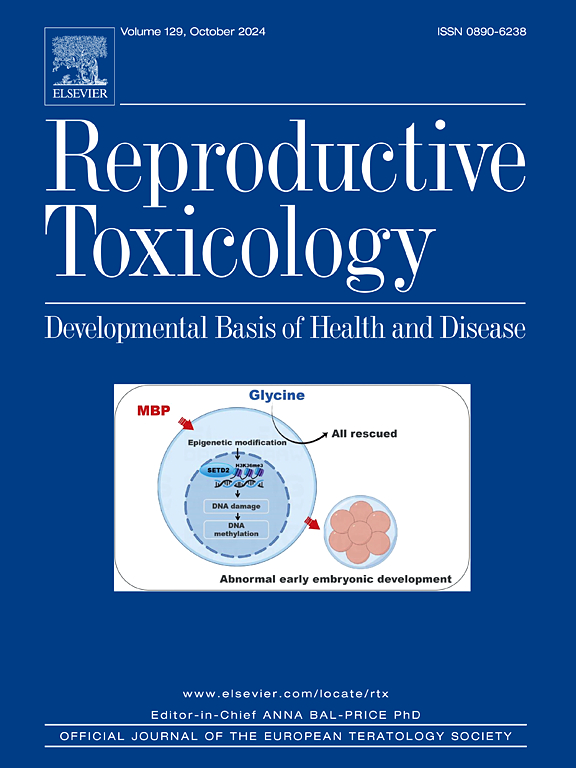亚慢性Kalach暴露对男性生殖系统和精子功能的影响:大鼠的硅模型和体内研究。
IF 3.3
4区 医学
Q2 REPRODUCTIVE BIOLOGY
引用次数: 0
摘要
Kalach 360 SL (KL)是一种草甘膦除草剂,是突尼斯使用最广泛的除草剂之一。本研究旨在评估亚慢性暴露于KL对成年大鼠在一个和两个精子发生周期后雄性生殖系统和精子参数的影响。15只大鼠随机分为3组:对照组(G1)和2个实验组(G2和G3),以102.2mg/kg / d的剂量暴露于KL,连续48 d。G2组和G3组分别于第48天和第96天处死。我们测量了血清睾酮和雌二醇水平、睾丸氧化应激标志物、附睾精子参数、精子线粒体膜电位(MMP)以及睾丸组织病理学和形态计量学作为生殖功能障碍的诊断指标。此外,我们用计算机模型补充了体内研究。Kl损害精子参数,改变MMP,促进氧化应激,影响睾丸形态,导致精管上皮高度降低和精子发生阻滞延迟。KL使48 d后血清睾酮水平显著下降(G2组),支持该除草剂的抗雄激素活性。值得注意的是,在停止暴露后,睾酮水平升高,精子浓度在第96天恢复正常(G3组)。计算方法显示,草甘膦与雄激素受体(2Q7K和3QKM)结合具有良好的亲和力和较强的分子相互作用,证实了体内结果。我们得出结论,KL可能会干扰精子发生,损害男性生育能力,并作为一种潜在的内分泌干扰物具有抗雄激素活性。本文章由计算机程序翻译,如有差异,请以英文原文为准。
Impact of sub-chronic exposure to Kalach on male reproductive system and sperm function: In silico modelling and in vivo study in rats
Kalach 360 SL (KL), a glyphosate-based herbicide, is among the most widely used herbicides in Tunisia. This study aimed to evaluate the impact of sub-chronic exposure to KL on the male reproductive system and sperm parameters in adult rats after one and two cycles of spermatogenesis. 15 rats were randomly divided into three groups: a control group (G1) and two experimental groups (G2 and G3), exposed to KL at a dose of 102.2 mg/kg each day for 48 days. Treated groups G2 and G3 were sacrificed at day 48 and at day 96, respectively. We measured serum levels of testosterone and oestradiol, oxidative stress markers in testis, epididymal sperm parameters, sperm mitochondrial membrane potential (MMP), as well as testicular histopathology and morphometry as diagnostic markers of reproductive dysfunction. Additionally, we complemented the in vivo study with in silico modelling. Kl impaired sperm parameters, altered MMP, promoted oxidative stress, and affected testicular morphology, leading to reduced seminiferous epithelium height and delayed spermatogenesis arrest. KL caused significant declines in serum testosterone levels after 48 days (G2 group), supporting the herbicide's anti-androgenic activity. Notably, following cessation of exposure, testosterone levels increased and sperm concentration returned to normal by day 96 (G3 group). The computational approach revealed that glyphosate binds to the androgen receptor (2Q7K and 3QKM) with good affinities and strong molecular interactions, corroborating the in vivo results. We conclude that KL may interfere with spermatogenesis, impair male fertility, and function as a potential endocrine disruptor with anti-androgenic activity.
求助全文
通过发布文献求助,成功后即可免费获取论文全文。
去求助
来源期刊

Reproductive toxicology
生物-毒理学
CiteScore
6.50
自引率
3.00%
发文量
131
审稿时长
45 days
期刊介绍:
Drawing from a large number of disciplines, Reproductive Toxicology publishes timely, original research on the influence of chemical and physical agents on reproduction. Written by and for obstetricians, pediatricians, embryologists, teratologists, geneticists, toxicologists, andrologists, and others interested in detecting potential reproductive hazards, the journal is a forum for communication among researchers and practitioners. Articles focus on the application of in vitro, animal and clinical research to the practice of clinical medicine.
All aspects of reproduction are within the scope of Reproductive Toxicology, including the formation and maturation of male and female gametes, sexual function, the events surrounding the fusion of gametes and the development of the fertilized ovum, nourishment and transport of the conceptus within the genital tract, implantation, embryogenesis, intrauterine growth, placentation and placental function, parturition, lactation and neonatal survival. Adverse reproductive effects in males will be considered as significant as adverse effects occurring in females. To provide a balanced presentation of approaches, equal emphasis will be given to clinical and animal or in vitro work. Typical end points that will be studied by contributors include infertility, sexual dysfunction, spontaneous abortion, malformations, abnormal histogenesis, stillbirth, intrauterine growth retardation, prematurity, behavioral abnormalities, and perinatal mortality.
 求助内容:
求助内容: 应助结果提醒方式:
应助结果提醒方式:


